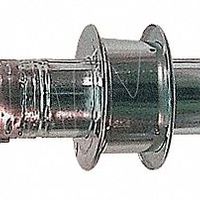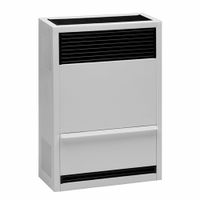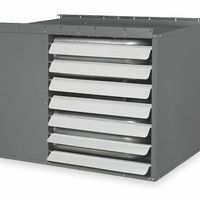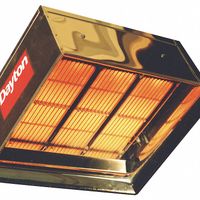Call +(254) 703 030 000 / 751 483 999 / 721 704 777
- Home
- Hvac And Refrigeration
- Heaters
- Gas Oil Kerosene Heaters
- Gas Wall Ceiling Heaters
.....Read More
Frequently Asked Questions
1. How do gas wall and ceiling heaters work?
Gas wall and ceiling heaters operate by burning natural gas or propane to produce heat, which is then distributed into the room. These heaters typically consist of a burner, a heat exchanger, and a fan or blower.
1. **Ignition and Combustion**: The process begins with the ignition of the gas. This can be done using a pilot light or an electronic ignition system. Once ignited, the gas burns in the burner, producing heat.
2. **Heat Exchanger**: The heat generated from the combustion is transferred to a heat exchanger. The heat exchanger is a metal component that absorbs the heat from the burning gas. It is designed to maximize the surface area in contact with the flame, ensuring efficient heat transfer.
3. **Air Circulation**: A fan or blower is used to circulate air over the heat exchanger. As the air passes over the hot surface, it absorbs the heat and warms up. This warm air is then pushed out into the room, raising the ambient temperature.
4. **Ventilation**: Proper ventilation is crucial for gas heaters to ensure that combustion by-products, such as carbon monoxide, are safely expelled outside. This is typically achieved through a flue or venting system that directs exhaust gases out of the building.
5. **Thermostat Control**: Most gas wall and ceiling heaters are equipped with a thermostat that allows users to set the desired temperature. The thermostat regulates the heater's operation, turning it on or off to maintain the set temperature.
6. **Safety Features**: Modern gas heaters include safety features such as oxygen depletion sensors and automatic shut-off mechanisms to prevent accidents and ensure safe operation.
These heaters are efficient for localized heating and are often used in spaces where central heating is impractical.
2. What are the benefits of using gas wall and ceiling heaters?
Gas wall and ceiling heaters offer several benefits:
1. **Efficiency**: These heaters are designed to provide direct heat to specific areas, reducing energy waste and improving overall efficiency. They quickly warm up spaces, making them ideal for spot heating.
2. **Space-Saving**: Wall and ceiling-mounted designs free up floor space, making them suitable for small or crowded areas. This is particularly beneficial in garages, workshops, or small apartments where floor space is limited.
3. **Cost-Effective**: Gas heaters generally have lower operating costs compared to electric heaters, especially in areas where natural gas is cheaper than electricity. They provide a cost-effective solution for heating needs.
4. **Consistent Heat**: Gas heaters provide a steady and consistent heat output, maintaining a comfortable temperature without the fluctuations often experienced with electric heaters.
5. **Quick Heating**: Gas heaters can rapidly increase the temperature of a room, providing immediate warmth. This is advantageous in cold climates where quick heating is necessary.
6. **Durability**: Gas heaters are typically robust and have a long lifespan, requiring less frequent replacement compared to some electric models.
7. **Versatility**: Available in various sizes and styles, gas wall and ceiling heaters can be used in residential, commercial, and industrial settings, offering flexibility in application.
8. **Reduced Humidity**: Unlike some electric heaters, gas heaters do not add moisture to the air, helping to maintain a comfortable indoor environment.
9. **Backup Heating**: In areas prone to power outages, gas heaters can serve as a reliable backup heating source, ensuring warmth even when electricity is unavailable.
10. **Environmentally Friendly**: Modern gas heaters are designed to be energy-efficient and produce fewer emissions, making them a more environmentally friendly option compared to older models.
3. How do you install a gas wall or ceiling heater?
1. **Choose Location**: Select a suitable location on the wall or ceiling, ensuring it is away from flammable materials and has proper clearance as specified by the manufacturer.
2. **Check Ventilation**: Ensure the area has adequate ventilation. If the heater requires venting, plan the vent path to the outside.
3. **Turn Off Gas Supply**: Shut off the main gas supply to prevent leaks during installation.
4. **Install Mounting Bracket**: Secure the mounting bracket to the wall or ceiling using appropriate anchors and screws. Ensure it is level and can support the heater's weight.
5. **Connect Gas Line**: Use a flexible gas line to connect the heater to the gas supply. Apply pipe joint compound or Teflon tape to threaded connections to prevent leaks.
6. **Install Venting (if required)**: Attach the vent pipe to the heater and route it to the outside, following local building codes and manufacturer instructions.
7. **Electrical Connection**: If the heater has an electric ignition or fan, connect it to the electrical supply. Ensure the power is off before making connections.
8. **Secure Heater**: Attach the heater to the mounting bracket, ensuring it is securely fastened.
9. **Test for Leaks**: Turn on the gas supply and use a gas leak detector or soapy water to check all connections for leaks. Tighten connections if necessary.
10. **Test Operation**: Turn on the heater and test its operation, ensuring it ignites properly and distributes heat evenly.
11. **Final Adjustments**: Make any necessary adjustments to the thermostat or controls for optimal performance.
12. **Safety Check**: Ensure all safety features, such as automatic shut-off, are functioning correctly.
13. **Clean Up**: Remove any debris and ensure the area around the heater is clear.
14. **Review Manual**: Refer to the manufacturer’s manual for any specific instructions or maintenance tips.
4. What is the difference between natural gas and propane heaters?
Natural gas and propane heaters differ primarily in fuel source, efficiency, cost, and installation requirements.
1. **Fuel Source**:
- Natural gas heaters use methane, delivered via pipelines. It's a continuous supply, ideal for homes with existing gas lines.
- Propane heaters use liquefied petroleum gas (LPG), stored in tanks. It's portable, suitable for areas without natural gas infrastructure.
2. **Efficiency**:
- Both can be highly efficient, but propane typically burns hotter, providing more energy per unit. This can make propane heaters more efficient in terms of heat output.
3. **Cost**:
- Natural gas is generally cheaper per unit than propane, making it more cost-effective for long-term use.
- Propane heaters might have higher operational costs due to fuel price and delivery charges.
4. **Installation**:
- Natural gas heaters require a connection to a gas line, which can be costly if not already available.
- Propane heaters need a storage tank, which can be installed above or below ground, offering flexibility in placement.
5. **Environmental Impact**:
- Both are cleaner than oil or coal, but natural gas is considered slightly more environmentally friendly due to lower carbon emissions.
6. **Safety**:
- Both require proper ventilation to prevent carbon monoxide buildup. Propane tanks need regular inspection for leaks.
7. **Portability**:
- Propane heaters are more portable, making them suitable for temporary or mobile setups, like RVs or outdoor events.
8. **Availability**:
- Natural gas is more common in urban areas, while propane is often used in rural or remote locations.
In summary, the choice between natural gas and propane heaters depends on availability, cost considerations, and specific heating needs.
5. Are gas wall and ceiling heaters energy efficient?
Gas wall and ceiling heaters can be energy efficient, but their efficiency depends on several factors, including the type of heater, installation, and usage.
1. **Type of Heater**: Modern gas heaters, especially those with high Annual Fuel Utilization Efficiency (AFUE) ratings, are designed to maximize energy use. Condensing models, for instance, can achieve efficiency ratings of 90% or higher by capturing and utilizing heat from exhaust gases.
2. **Installation**: Proper installation is crucial for efficiency. Wall and ceiling heaters should be installed in locations that allow for optimal heat distribution. Poor installation can lead to heat loss and reduced efficiency.
3. **Insulation and Sealing**: The efficiency of gas heaters is also influenced by the insulation of the space. Well-insulated rooms retain heat better, reducing the workload on the heater. Proper sealing of windows and doors prevents drafts, further enhancing efficiency.
4. **Usage**: Efficient use of gas heaters involves setting appropriate temperatures and using programmable thermostats to reduce energy consumption when heating is not needed. Regular maintenance, such as cleaning filters and checking for leaks, ensures the heater operates efficiently.
5. **Ventilation**: Proper ventilation is necessary to ensure safety and efficiency. Ventless models, while convenient, may not be as efficient due to potential heat loss through necessary ventilation.
6. **Comparative Efficiency**: Compared to electric heaters, gas heaters can be more cost-effective in areas where natural gas is cheaper than electricity. However, their environmental impact should be considered, as they emit greenhouse gases.
In summary, gas wall and ceiling heaters can be energy efficient if they are modern, properly installed, well-maintained, and used in well-insulated spaces. Their efficiency is also influenced by local energy costs and environmental considerations.
6. What safety precautions should be taken with gas wall and ceiling heaters?
1. **Installation**: Ensure professional installation by a certified technician to guarantee proper setup and compliance with local codes.
2. **Ventilation**: Confirm adequate ventilation to prevent the buildup of carbon monoxide. Install carbon monoxide detectors near the heater and in sleeping areas.
3. **Clearance**: Maintain recommended clearance from combustible materials such as curtains, furniture, and bedding. Follow manufacturer guidelines for specific distances.
4. **Regular Maintenance**: Schedule annual inspections and maintenance by a qualified technician to check for leaks, blockages, and proper operation.
5. **Pilot Light**: Ensure the pilot light is functioning correctly. If it goes out frequently, have it inspected by a professional.
6. **Gas Leaks**: Be vigilant for the smell of gas. If detected, turn off the heater, ventilate the area, and contact a professional immediately. Do not use electrical switches or open flames.
7. **Thermostat and Controls**: Regularly check that the thermostat and controls are working properly to prevent overheating.
8. **Safety Features**: Ensure the heater has safety features such as an automatic shut-off in case of overheating or tip-over.
9. **Children and Pets**: Keep children and pets away from the heater to prevent burns or accidental tampering.
10. **Emergency Plan**: Have an emergency plan in place, including evacuation routes and emergency contact numbers.
11. **User Manual**: Read and follow the manufacturer’s instructions and safety guidelines provided in the user manual.
12. **Fire Extinguisher**: Keep a fire extinguisher nearby and ensure it is suitable for gas fires.
13. **No Obstructions**: Do not block air intake or exhaust vents to ensure efficient operation and prevent overheating.
14. **Turn Off When Not in Use**: Always turn off the heater when leaving the room or going to sleep.
7. How do you maintain and clean gas wall and ceiling heaters?
To maintain and clean gas wall and ceiling heaters, follow these steps:
1. **Turn Off the Heater**: Ensure the heater is completely turned off and cool before starting any maintenance or cleaning.
2. **Inspect for Damage**: Check for any visible damage or wear, such as cracks or rust, and ensure all components are securely attached.
3. **Clean the Exterior**: Use a soft cloth or vacuum with a brush attachment to remove dust and debris from the exterior surfaces. Avoid using water or harsh chemicals.
4. **Remove and Clean the Grille**: Detach the grille or cover, if possible, and clean it with warm, soapy water. Rinse thoroughly and let it dry completely before reattaching.
5. **Vacuum the Interior**: Use a vacuum cleaner with a hose attachment to remove dust and debris from the interior components, including the burner and heat exchanger.
6. **Check the Burner**: Inspect the burner for any blockages or buildup. Use a soft brush to gently clean the burner ports and ensure they are free of obstructions.
7. **Inspect the Pilot Light and Thermocouple**: Ensure the pilot light is clean and burning blue. If it’s yellow or flickering, it may need adjustment or cleaning. Check the thermocouple for any signs of wear or damage.
8. **Clean the Ventilation System**: Ensure the vents and flues are clear of obstructions. Use a brush or vacuum to clean them if necessary.
9. **Check Gas Connections**: Inspect gas connections for leaks by applying a soapy water solution. Bubbles indicate a leak, which requires immediate professional attention.
10. **Professional Servicing**: Schedule annual maintenance with a qualified technician to ensure the heater operates safely and efficiently.
11. **Test the Heater**: After cleaning, turn the heater back on and test it to ensure it’s functioning correctly.
Regular maintenance and cleaning will enhance the efficiency and lifespan of gas wall and ceiling heaters.




